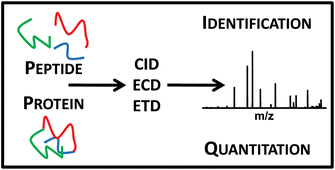Dissociation techniques in mass spectrometry-based proteomics†
Abstract
The field of proteomics, the large-scale analysis of

- This article is part of the themed collection: Emerging Investigators
* Corresponding authors
a
School of Biosciences, College of Life and Environmental Sciences, University of Birmingham, Edgbaston, Birmingham, UK
E-mail:
H.J.Cooper@bham.ac.uk
Fax: +44 (0)121 414 5925
Tel: +44 (0)121 414 7527
The field of proteomics, the large-scale analysis of

 Please wait while we load your content...
Something went wrong. Try again?
Please wait while we load your content...
Something went wrong. Try again?
A. W. Jones and H. J. Cooper, Analyst, 2011, 136, 3419 DOI: 10.1039/C0AN01011A
To request permission to reproduce material from this article, please go to the Copyright Clearance Center request page.
If you are an author contributing to an RSC publication, you do not need to request permission provided correct acknowledgement is given.
If you are the author of this article, you do not need to request permission to reproduce figures and diagrams provided correct acknowledgement is given. If you want to reproduce the whole article in a third-party publication (excluding your thesis/dissertation for which permission is not required) please go to the Copyright Clearance Center request page.
Read more about how to correctly acknowledge RSC content.
 Fetching data from CrossRef.
Fetching data from CrossRef.
This may take some time to load.
Loading related content
